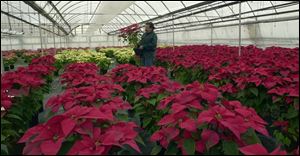
Weather, labor hurt Ohio poinsettias
12/5/2000
Pedro Martinez, an employee at Dennis Greenhouse on Hill Avenue, checks out a poinsettia plant.
Ohio greenhouses, which had the second highest poinsettia sales in the country in 1996 dropped to fifth last year, a victim of cheaper labor and warmer temperatures favoring production in North Carolina and Texas.
The state is still growing about 4 million pots of poinsettias, down less than 2 per cent from 1996, but chain stores like to price poinsettias low, forcing Ohio greenhouses and florists to take smaller price increases.
“I'm amazed to see in the stores what you can get for $5,” said Judy Dennis, owner of Dennis Greenhouse on Hill Avenue, which raised more than 6,000 poinsettias.
Growers have said for years that poinsettias are barely profitable and the only reason they raise them is because they're the only viable crop for this time of year and major customers like to buy all of their plants from one greenhouse.
In the South, a swell of recent immigrants from Mexico and the Caribbean provide a cheaper labor market than in the Toledo area, which has numerous greenhouses.
Texas is further from the largest cities and thus from the most demand for poinsettias, but its greenhouses need less fuel to keep temperatures in the 60s.
Large Ohio growers sometimes contract their fuel prices years in advance, said John Morris, head grower, at Lakewood Greenhouse, Inc., in Wood County's Lake Township. But those with contracts expiring this winter are facing much higher prices and last month was much cooler than November, 1999.
Lakewood, one of the largest growers in the area, raised about 200,000 pots of poinsettias this year. That number has declined by about 5,000 a year the past couple of years.
Mr. Morris predicts Ohio greenhouses will choose poinsettia varieties next year that can be raised at the lowest temperatures, about 62 degrees, instead of showier varieties that need up to 68 degrees. The difference can mean a 10 to 12 per cent fuel savings.
They might also try harder to sell poinsettias earlier in November. Much hardier varieties look good for weeks and selling plants earlier helps greenhouses save on fuel.
Some growers see promise in trendy colors that are developed by the industry, feeling that consumers pick up an extra poinsettia in a trendy color to give as a gift when they're buying the traditional reds and whites for themselves.
Red still accounts for more than 70 per cent of the market and white and pink each claim 7 per cent, according to Paul Ecke Ranch, a huge California breeder. But newer varieties such as marble, Jingle Bells, Plum Pudding, and Monet account for 13 per cent.